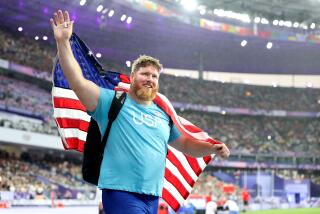Drugs Dim Glow of Victory for U.S. Shotputters
- Share via
BARCELONA, Spain — It was one of track and field’s truly inglorious moments. The medalists in the men’s shotput sat at a dais Friday night to meet the international media after the first track competition of these Olympics. But instead of discussions on technique, strategy and hard work, the press conference was all about drug use.
For the first time in Olympic history, three medalists in one event had all, at one time, been banned for taking performance-enhancing drugs.
The rap sheets:
* Gold medal, Mike Stulce, United States. Winning throw, 71 feet 2 1/2 inches. Suspended for two years in March, 1990, after testing positive for synthetic testosterone, a muscle-building drug.
* Silver medal, Jim Doehring of Fallbrook, in northern San Diego County. Throw of 68-9 1/4. Suspended for two years in December, 1990, for excessive testosterone, reinstated after 18 months.
* Bronze medal, Viatcheslav Lykho of the Commonwealth of Independent States. Throw of 68-8 1/2. Suspended for three months for use of banned stimulants in August, 1990.
Doehring, 30, has an additional distinction. He is serving five years’ probation on a federal drug charge--conspiring to possess amphetamine with intent to distribute. His status as a convicted felon caused the U.S. Olympic Committee some consternation a few weeks ago, when the USOC discussed whether it could keep an athlete with a criminal record off the U.S. team.
The USOC found no such provision and Doehring was allowed to compete.
One question posed before the U.S. team left was whether Doehring’s passport had been revoked, as is customary for felons. According to the USOC, however, Olympic athletes may travel on their Olympic identity cards and are admitted as a courtesy by the host country.
Unclear, too, are the terms of Doehring’s probation and why he was allowed to leave the country. Louanne Hanson, Doehring’s federal probation officer in San Diego, would not comment on that Friday.
The drug controversy overshadowed a breakthrough performance by the American throwers. The 1-2 U.S. finish was the first in the shot since Randy Matson and George Woods did it in 1968 at the Mexico City Olympics. Olympic drug testing began in 1976 at Montreal.
But the discussion on the first day of track and field competition was less about performance and more about performance enhancement. And not just among the medalists. The fourth-place finisher was Werner Gunthor of Switzerland, the world champion. Gunthor has spent the first week of the Olympic Games denying persistent rumors of drug use.
For Stulce, who attended Texas A&M;, the winning throw was his best ever. And Doehring came close to his personal best. But neither is the best American shotputter. That man is Randy Barnes, who is also the world record-holder in the event. Barnes is at home in Texas, under a two-year drug suspension.
All of which makes officials of the sport cringe. For them, Friday night’s press conference was excruciating, coming on the heels of the drug-related suspension of three British athletes here Thursday. There was little of the excitement that normally accompanies an Olympic medal.
“Mr. Stulce,” asked a reporter from Sweden, “do you think your medal is tainted?”
Stulce replied politely no, that he did not think so.
“A question for the bronze medalist,” shouted a British reporter. “What is your comment on the fact that you three have made Olympic history by becoming the first three medalists to have been suspended for drug use?”
Lykho, the Russian, once he got the drift of the questions early in the press conference, had taken off his simultaneous translation device. Then picking it up and listening in, he answered with a shrug, “Yes, anything can happen. I hadn’t thought about it.”
From the back of the room: “Question for all three. Are you clean, and why should we believe you?”
It was an exasperating experience for the athletes, who had hoped to review their triumphs rather than their drug busts.
“I wish the media would focus on the positive,” said Doehring.
Stulce, 25, a hulking 6 feet 3 inches and 270 pounds, said the stigma of being a shotputter is unshakable.
“It’s getting to the point in the sport where people look at you and say you are a cheater,” he said.
However, it’s difficult for any athlete to put testing behind him as long as he competes. The shotput medalists, as are all track and field medal winners, were tested after their events. The results will be known in a few days.
The Olympic ideal, marketed by hundreds of multinational sporting goods companies, takes a beating every time the word drugs is associated with sport. Track and field has not yet recovered from the controversy over the banning of 1988 Olympic gold medal sprinter Ben Johnson of Canada. To combat this image, sports officials speak sweepingly of a war on drugs and how near-blanket testing for five categories of performance-enhancing drugs has ended drug use.
But with frequent positive tests, their claims seem hollow.
Asked Friday if it would be possible to break the world record (75-10 1/4) without using drugs, Stulce thought for a moment and replied, “I couldn’t.”
More to Read
Go beyond the scoreboard
Get the latest on L.A.'s teams in the daily Sports Report newsletter.
You may occasionally receive promotional content from the Los Angeles Times.







